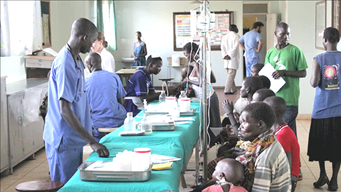What is CD4 & Why is it Important?

Human immunodeficiency virus (HIV) targets the immune system and in its most advanced stage of infection manifests as acquired immunodeficiency syndrome (AIDS). This can take from 2 to 15 years to develop depending on the individual. 1
The virus destroys and impairs the function of immune cells so that infected people gradually become immune-deficient and therefore susceptible to certain types of cancer and opportunistic infections (OI). People with healthy immune systems can more easily fight off these types of infection.
All cells in the human body express certain proteins and other molecules either on the cell surface or inside the actual cell. To make it easier to identify the cells, the scientific community has given each molecule a specific number. CD4 is a protein on the surface of T helper cells, a subset of T cells and play an important part in the body’s immune system. These white blood cells circulate throughout the body to find and destroy bacteria, invading organisms - and viruses.
If you want to know the health of person’s immune system, you measure the number of CD4 cells they have in their blood. Following diagnosis, a patient should obtain a CD4 count for a ‘baseline measurement’. This provides a benchmark to compare with future tests results.
A normal CD4 count is from 500 to 1,400 cells per cubic millimeter of blood. CD4 counts will decrease over time in people not receiving antiretroviral treatment. The weaker a patient’s immune status, the more likely it is that an opportunistic infection will prove fatal. In the case of HIV, knowing the number of CD4 cells in the body is a good indicator of the severity of HIV infection. People who have low CD4 counts - below 200 - are at very high risk of opportunistic infections2, 3.
The CD4 count is consistently linked to a poor outcome even if a patient is feeling well. Some people can have high CD4 counts and be more vulnerable than they realize for other reasons. Some patients can have low CD4 counts but still feel well, with few complications. However, they are at risk of becoming seriously ill if they don’t start HIV treatment3.
Current treatment for HIV patients is to start on antiretroviral therapy (ART) as soon as possible after diagnosis4. ART is designed to decrease the number of virus particles in a patient’s blood. All HIV patients are now started on ART regardless of whether the CD4 count is high or low. As their immune status improves in response to effective ART, the CD4 count should also increase. However, if the CD4 count keeps going down despite several months of adherence to ART, it indicates that the virus is developing resistance to the ART drugs.
The World Health Organisation (WHO) has taken a two-fold approach to HIV detection and monitoring. For overall monitoring of a patient’s disease status, they recommend viral load analysis. However, their guidelines also stress the importance of maintaining CD4 measurement4, 5. This is especially important for people with advanced disease, where ART fails, or where a patient finds it difficult to adhere to a treatment programme. Patients with very low CD4 counts are likely to need specific drugs to prevent specific opportunistic infections alongside their ART. As their CD4 count rises, it may be possible to stop OI medications.
Measuring a patient’s CD4 count is therefore different from viral load monitoring. Clinicians measure CD4 to understand a patient’s immune status and their vulnerability to potentially fatal opportunistic infections. Monitoring viral load helps to see the effectiveness of specific retroviral therapy to supress the virus. Both have important clinical roles to play in saving the lives of HIV patients.
Why count CD4 cells?
CD4 T lymphocytes (CD4 cells) are a type of white blood cell in human blood that play a major role in protecting the body from infection.
Talk to an expert about CD4 testing solutions
What is CD4 & Why is it Important?

HIV Advanced Disease Management
More than a third of people starting ART have advanced HIV disease, and an increasing number of patients re-present to care at an advanced stage of HIV disease following disengagement from care.
The Future of CD4 Testing
It is now standard practice to offer HIV testing, and put patients onto antiretroviral therapies as soon as they receive a positive diagnosis, not only prolonging but also enhancing the quality of their lives.

CD4 & Viral Load – Why its Significant to Use Both
For too long, CD4 testing has been on the wane in countries with high incidences of HIV. Yet it is the recommended way to identify people in advanced stages of the disease and whose reduced immunity therefore exposes them to potentially fatal, opportunistic infections.
HIV Pandemic & the UNAIDS 90-90-90 Initiative
The global pandemic caused by HIV, has already claimed more than 32 million lives. In 2018 alone, 770 000 people died from HIV-related causes globally.References
- https://www.who.int/news-room/fact-sheets/detail/hiv-aids
- World Health Organization (2017): What’s new in treatment monitoring: Viral load and VCD4 testing. Information Note WHO/HIV/2017.22
- World Health Organization (2017): Guidelines for managing advanced HIV disease and rapid initiation of antiretroviral therapy, page 6.
- World Health Organization (2017): Guidelines for managing advanced HIV disease and rapid initiation of antiretroviral therapy
- https://www.who.int/hiv/pub/arv/arv-2016/en/. World Health Organization (2016): Consolidated guidelines on the use of antiretroviral drugs for treating and preventing HIV infection: recommendations for a public health approach – 2nd ed.

